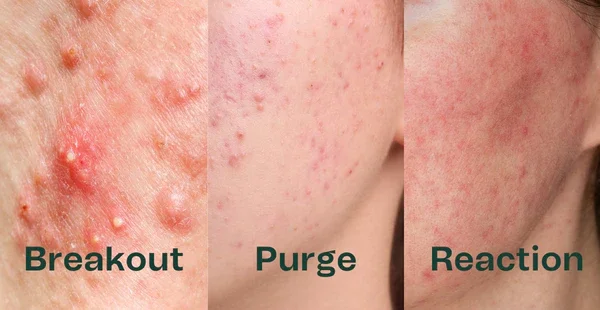Acne From a Product: Is It Purging or a Breakout? How to Tell the Difference
Sometimes, when you start using a new skincare product, your skin can flare up before it starts looking better. Breakouts might appear unexpectedly, and it can feel discouraging—especially when you hoped for smoother, calmer skin.
This doesn’t always mean your skin is rejecting the product. Often, it’s purging, a natural, temporary process where your skin speeds up its renewal and gently clears out impurities.
In this article, I explain what purging is, why it happens, how to recognize it, and how you can manage it—so you can feel confident that these early bumps are often just a step toward healthier, clearer skin.
Table of Contents:
What Is Purging and What Causes It?
How to Recognize Whether It’s Purging or a Reaction
Tips to Minimize Purging
What Is Purging and What Causes It?
Purging—sometimes called “initial breakouts” or “skin clearing”—is a relatively rare phenomenon, but it can feel worrying when it happens. The good news is that if you’re experiencing purging, it’s usually a positive sign: the product you’re using is working and having an effect.
Purging is temporary, typically lasting 4–8 weeks, and affects about 10–20% of people. It usually appears shortly after introducing a new product. But what exactly happens in your skin, and what causes it?
Purging occurs when certain active ingredients accelerate your skin’s natural renewal process and influence the formation of breakouts. The most common triggers include:
BHA (salicylic acid) – gently exfoliates inside pores
AHA (like glycolic or lactic acid) – speed up surface exfoliation
Retinol – promotes skin cell turnover
Less commonly: azelaic acid or benzoyl peroxide
On the other hand, ingredients like:
Hyaluronic acid
Soothing antioxidants or moisturizers
do not cause purging. If you notice breakouts after using these types of products, it usually indicates that your skin doesn’t tolerate the formula, and it’s best to stop using it. These breakouts are not part of a “clearing” process—they are a reaction showing that something isn’t right for your skin.
With true purging, no completely new pimples are forming. Instead, breakouts that were already developing beneath the surface for weeks or months suddenly come to the surface faster. Essentially, purging brings hidden blemishes forward, rather than creating entirely new ones.
How to Recognize Whether It’s Purging or a Reaction
One of the biggest questions when your skin flares up after a new product is whether it’s purging or a negative reaction. Knowing the difference helps you decide whether to continue using the product or stop immediately.
Signs That It’s Likely Purging (and Worth Continuing the Product)
You’ve started a new product that contains an active ingredient known to speed up skin renewal, such as: AHA, BHA, Retinol, Azelaic acid, Benzoyl peroxide.
Breakouts appear shortly after starting the product—usually within a few uses or 1–2 weeks.
Pimples appear in areas where you normally get them.
The breakouts are often small or mild.
Overall, your skin may still look healthier or smoother in areas not affected by the purging.
Signs That It’s Likely a Reaction (and You Should Stop the Product)
You’ve started a new product that does not contain skin-renewing active ingredients.
Breakouts appear in areas where you normally don’t get pimples, or in additional areas as well.
Recognizing these signs early can help you make confident decisions about your skincare routine, avoiding unnecessary frustration while supporting your skin’s natural clearing process.
Tips to Minimize Purging
As mentioned earlier, purging affects only a small portion of people. So if you’re introducing a new product into your routine, the first step is not to panic—there’s a good chance you won’t experience any initial worsening of your skin.
If you’d like to take extra steps to reduce the risk of purging, here are a few strategies:
Start slowly: Begin using the product every few days instead of daily, gradually increasing frequency.
Try a gentler version first: Using a milder formulation can help your skin adjust. Keep in mind that the effects may appear more gradually, but this approach can lower the chance of purging.
Another option is to accept that a short adjustment period may happen and simply ride it out. During this time, it’s important to treat your skin gently—avoid picking, scrubbing, or irritating it.
Extra tips for support during purging:
Maintain proper hydration—use moisturizers suitable for your skin type.
Include soothing, anti-inflammatory ingredients in your routine, such as a calming serum.
Avoid introducing multiple new active products at the same time to minimize stress on your skin.
With these strategies, you can navigate purging more comfortably and give your skin the best chance to adjust while still benefiting from the active ingredients.
Summary
Purging can feel frustrating, but it’s often a sign that your skin is responding to active ingredients and starting its natural clearing process. Remember, it’s temporary, usually lasting just a few weeks, and only affects a small percentage of people. By observing your skin carefully, using gentle care, and staying consistent with your routine, you can navigate this phase with confidence. Treat your skin kindly, support it with hydration and soothing ingredients, and soon enough, you’ll likely see the clearer, healthier skin you’ve been working toward.

